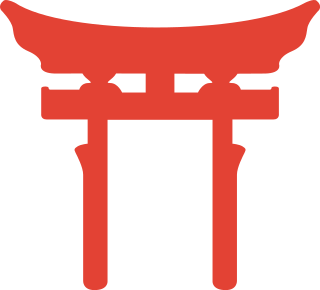
Asakusa Shrine is a Shinto shrine located in the Asakusa district of Tokyo, Japan.

Nezu Shrine is a Shinto shrine located in the Bunkyō ward of Tokyo, Japan.

Shinto architecture is the architecture of Japanese Shinto shrines.

Sumiyoshi-zukuri (住吉造) is an ancient Shinto shrine architectural style which takes its name from Sumiyoshi Taisha's honden in Ōsaka. As in the case of the taisha-zukuri and shinmei-zukuri styles, its birth predates the arrival in Japan of Buddhism.

This is the glossary of Shinto, including major terms the casual reader might find useful in understanding articles on the subject. Words followed by an asterisk (*) are illustrated by an image in one of the photo galleries. Within definitions, words set in boldface are defined elsewhere in the glossary.

Nishina Shinmei Shrine is a Shinto shrine in Ōmachi, Nagano Prefecture, Japan. The shrine is the oldest extant example of shinmei-zukuri, one of three architectural styles which were conceived before the arrival of Buddhism in Japan. It predates in fact the more famous Ise Shrine, which shares the style and has been since antiquity rebuilt every twenty years. It was ranked as a Prefectural Shrine under the Modern system of ranked Shinto shrines.

Chigi, Okichigi (置千木) or Higi (氷木) are forked roof finials found in Japanese and Shinto Architecture. Chigi predate Buddhist influence and are an architectural element endemic to Japan. They are an important aesthetic aspect of Shinto shrines, where they are often paired with katsuogi, another type of roof ornamentation. Today, chigi and katsuogi are used exclusively on Shinto buildings and distinguish them from other religious structures, such as Buddhist temples in Japan.

Taisha-zukuri or Ōyashiro-zukuri (大社造) is the oldest Shinto shrine architectural style. Named after Izumo Taisha's honden (sanctuary), like Ise Grand Shrine's shinmei-zukuri style it features a bark roof decorated with poles called chigi and katsuogi, plus archaic features like gable-end pillars and a single central pillar. The honden's floor is raised above the ground through the use of stilts . Like the shinmei-zukuri and sumiyoshi-zukuri styles, it predates the arrival in Japan of Buddhism.

Shinmei-zukuri (神明造) is an ancient Japanese architectural style typical of Ise Grand Shrine's honden, the holiest of Shinto shrines. It is most common in Mie Prefecture.

Kasuga-zukuri (春日造) is a traditional Shinto shrine architectural style which takes its name from Kasuga Taisha's honden. It is characterized by the use of a building just 1x1 ken in size with the entrance on the gabled end covered by a veranda. In Kasuga Taisha's case, the honden is just 1.9 m x 2.6 m.

The nagare-zukuri or nagare hafu-zukuri is a traditional Shinto shrine architectural style characterized by a very asymmetrical gabled roof projecting outwards on one of the non-gabled sides, above the main entrance, to form a portico. This is the feature which gives it its name. It is the most common style among shrines all over the country. That the building has its main entrance on the side which runs parallel to the roof's ridge makes it belong to the hirairi or hirairi-zukuri (平入・平入造) style.

The hachiman-zukuri (八幡造) is a traditional Japanese architectural style used at Hachiman shrines in which two parallel structures with gabled roofs are interconnected on the non-gabled side, forming one building which, when seen from the side, gives the impression of two. The front structure is called gaiden, the rear one naiden, and together they form the honden. The honden itself is completely surrounded by a cloister-like covered corridor called kairō' (回廊). Access is made possible by a gate called rōmon (楼門).

Hiyoshi-zukuri or hie-zukuri (日吉造), also called shōtei-zukuri / shōtai-zukuri (聖帝造) or sannō-zukuri (山王造) is a rare Shinto shrine architectural style presently found in only three instances, all at Hiyoshi Taisha in Ōtsu, Shiga, hence the name. They are the East and West Honden Hon-gū (本殿本宮) and the Sessha Usa Jingū Honden (摂社宇佐神宮本殿). It is characterized by a hip-and gable roof with verandas called hisashi on the sides. It has a hirairi structure, that is, the building has its main entrance on the side which runs parallel to the roof's ridge.

Ishi-no-ma-zukuri (石の間造), also called gongen-zukuri (権現造), yatsumune-zukuri (八棟造) and miyadera-zukuri (宮寺造), is a complex Shinto shrine structure in which the haiden, or worship hall, and the honden, or main sanctuary, are interconnected under the same roof in the shape of an H.

Ōsaki Hachimangū (大崎八幡宮) is a Shinto shrine in Aoba-ku, Sendai, Miyagi, Japan. The main shrine building has been designated a National Treasure of Japan.

The kagura-den, also called maidono or buden (舞殿) with reference to the bugaku traditional dance, is the building within a Shinto shrine where the sacred dance (kagura) and music are offered to the kami during ceremonies. It was originally just a temporary stage, first mentioned in a 9th-century text describing a maidono built in front of Hirano Shrine. In about a century it had become a permanent shrine feature, and its use was extended until its function as a worship hall prevailed over the original. It is now used also for weddings and Noh plays. Some scholars believe the heiden, or hall of worship, has its origins in the kagura-den.

Oji Shrine is a Shinto shrine located in the Kita-ku ward of Tokyo, Japan.




















